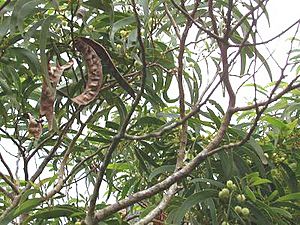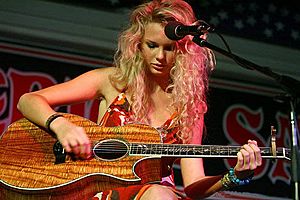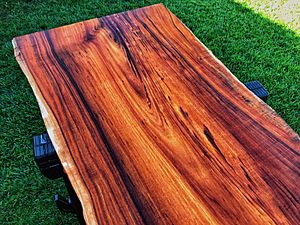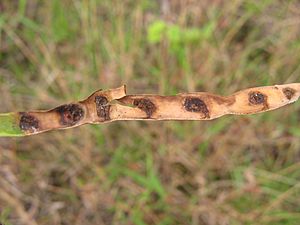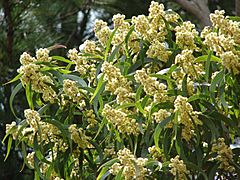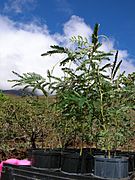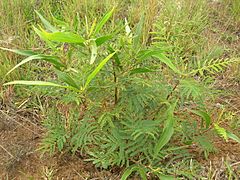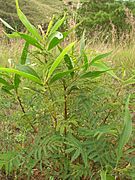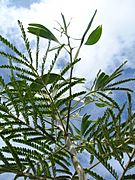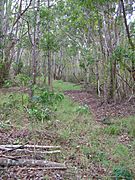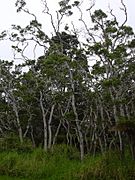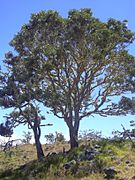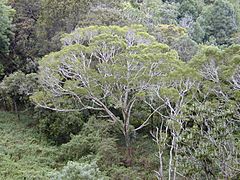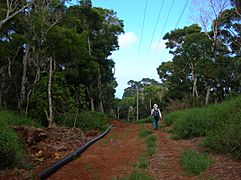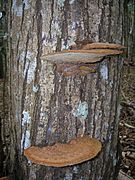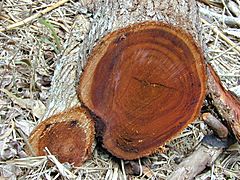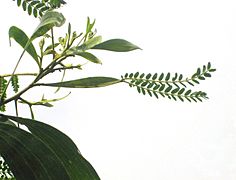Koa facts for kids
Quick facts for kids Koa |
|
|---|---|
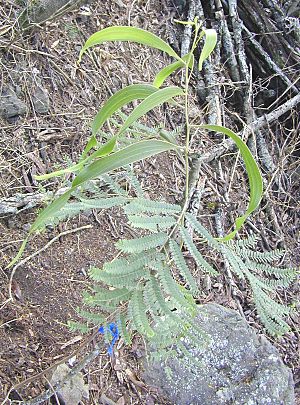 |
|
| A young koa tree showing compound leaves and phyllodes | |
| Conservation status | |
| Scientific classification | |
| Genus: |
Acacia
|
| Species: |
koa
|
The Acacia koa is a type of flowering tree that belongs to the pea family (Fabaceae). It grows only in the Hawaiian Islands, where it is the second most common tree. You can find many koa trees on Hawaiʻi, Maui, and Oʻahu. Its Hawaiian name, koa, also means brave, bold, fearless, or warrior.
Contents
What is the Koa Tree Like?
Koa is a large tree. It usually grows to be about 15 to 25 meters (50 to 80 feet) tall. Its branches can spread out 6 to 12 meters (20 to 40 feet) wide. In very rich volcanic soil, a koa tree can grow even taller, up to 30 meters (100 feet). It can also have a huge spread of 38 meters (125 feet). Koa is one of the fastest-growing trees in Hawaii. It can grow 6 to 9 meters (20 to 30 feet) in just five years if it's in a good spot.
Leaves of the Koa Tree
When a koa plant is young, it has compound leaves. These leaves have 12 to 24 pairs of tiny leaflets, much like other plants in the pea family. But when the tree is about 6 to 9 months old, it starts growing thick, sickle-shaped "leaves." These are not true leaves. They are called phyllodes. Phyllodes are actually widened leaf stems that look like leaves.
The phyllodes stand upright, which helps sunlight pass through to the lower parts of the tree. On an adult koa tree, these phyllodes completely replace the true leaves. They are usually 7 to 25 centimeters (3 to 10 inches) long and 0.5 to 2.5 centimeters (0.2 to 1 inch) wide.
Koa Tree Flowers
The Flowers of the koa tree are pale-yellow and round. They look like small balls and are about 8 to 10 millimeters (0.3 to 0.4 inches) across. Koa trees can flower at different times of the year, or even all year round, depending on where they are located.
Koa Tree Fruit and Seeds
Koa trees start making Fruit when they are between 5 and 30 years old. The fruit are legumes, which are also called pods. These pods are 7.5 to 15 centimeters (3 to 6 inches) long and 1.5 to 2.5 centimeters (0.6 to 1 inch) wide. Each pod usually holds about 12 seeds.
The seeds are oval-shaped and about 6 to 12 millimeters (0.2 to 0.5 inches) long. They are dark brown or black. The pods are ready when they change color from green to brown or black. Koa seeds have a very hard outer shell. This hard shell allows them to stay asleep for up to 25 years! To make the seeds sprout, their hard coating needs to be scratched or broken. This process is called scarification.
Where Koa Trees Live (Habitat)
Koa trees are found only on the Hawaiian Islands. They grow on Hawaiʻi, Molokaʻi, Maui, Lānaʻi, Oʻahu, and Kauaʻi. They can be found at different heights, from 100 to 2300 meters (330 to 7,500 feet) above sea level. Koa trees need a lot of rain, about 850 to 5000 millimeters (33 to 200 inches) each year.
They prefer Soil that is slightly acidic to neutral (pH of 4 to 7.4). This soil is often made from volcanic ash or is well-drained. Koa trees can grow in very new volcanic soils because they can add nitrogen to the soil. Koa and ʻōhiʻa lehua trees often form the top layer of mixed forests in Hawaii. They are also common in wet forests.
How People Use Koa Wood
In ancient times, Hawaiians used the trunk of the koa tree to build waʻa (dugout outrigger canoes). They also made papa heʻe nalu (surfboards) from koa wood. Only certain types of surfboards, like paipo (bodyboards), kikoʻo, and alaia surfboards, were made from koa. The longest surfboards, called olo, were made from the lighter wiliwili wood.
Koa wood is reddish and is similar in strength and weight to Black Walnut wood. It is very popular for wood carving and making furniture. Koa is also known as a tonewood. This means it's great for making musical instruments like ukuleles, acoustic guitars, and Hawaiian steel guitars. Some electric guitar companies have also used koa wood for their guitars.
Growing koa trees for wood takes a long time. It can take 20 to 25 years for a tree to grow large enough to be useful.
Koa's Family Tree
The only other Pacific Islands that have native Acacia species are the Hawaiian Islands and Vanuatu. A tree called A. heterophylla from Réunion Island is very similar to koa. Scientists believe it is koa's closest relative. Studies in 2014 showed they are indeed very closely related. They likely separated from a common ancestor about 1.4 million years ago. Both species probably came from an older Acacia species in Australia, called Acacia melanoxylon. It's thought that birds like petrels carried the seeds across the ocean.
A close relative of koa is the koaiʻa, or koaiʻe (A. koaia). This tree grows in dry areas. You can tell it apart from koa because its seeds are smaller and arranged end-to-end in the pod, not side by side. Its phyllodes are also usually straighter. Koaiʻa wood is harder and has a finer grain than koa wood. Koaiʻa trees have been greatly affected by cattle grazing and are now rare.
Protecting Koa Trees (Conservation)
The number of koa trees has gone down because of cattle grazing and logging. Many wet forest areas, where the biggest koa trees grow, have been cut down. Now, most koa wood comes from dead or dying trees, or from farms on private land. In the past, large, straight koa trees were used for outrigger canoes. But today, there are very few koa trees left that are big and straight enough for this.
Where cattle are present, new koa trees almost never grow. However, if cattle are removed, koa trees are one of the few native Hawaiian plants that can sprout in grasslands. They can help bring back the native forest. Sometimes, to start reforestation in a pasture, farmers will use a tool to break up the soil. This helps to scratch the seeds already in the soil, which makes many koa seeds sprout.
Experiments have shown that ʻōhiʻa lehua trees grow best in pastures when planted under koa trees. This is because koa trees help keep the ground warmer. This prevents frost from damaging the young ʻōhiʻa lehua seedlings.
Koa in Nature (Ecology)
Koa is an important host plant for some animals. The caterpillars of the green Hawaiian blue butterfly (Udara blackburni) eat koa flowers and fruits. Adult green Hawaiian blue butterflies drink nectar from the flowers. The adult Kamehameha butterfly (Vanessa tameamea) drinks koa sap. The koa bug (Coleotichus blackburniae) uses its mouthpart to suck the insides out of koa seeds. Koa trees can also get sick from a disease called koa wilt.
Gallery
-
Acacia koa with phyllode between the branch and the compound leaves
See also
 In Spanish: Acacia koa para niños
In Spanish: Acacia koa para niños



